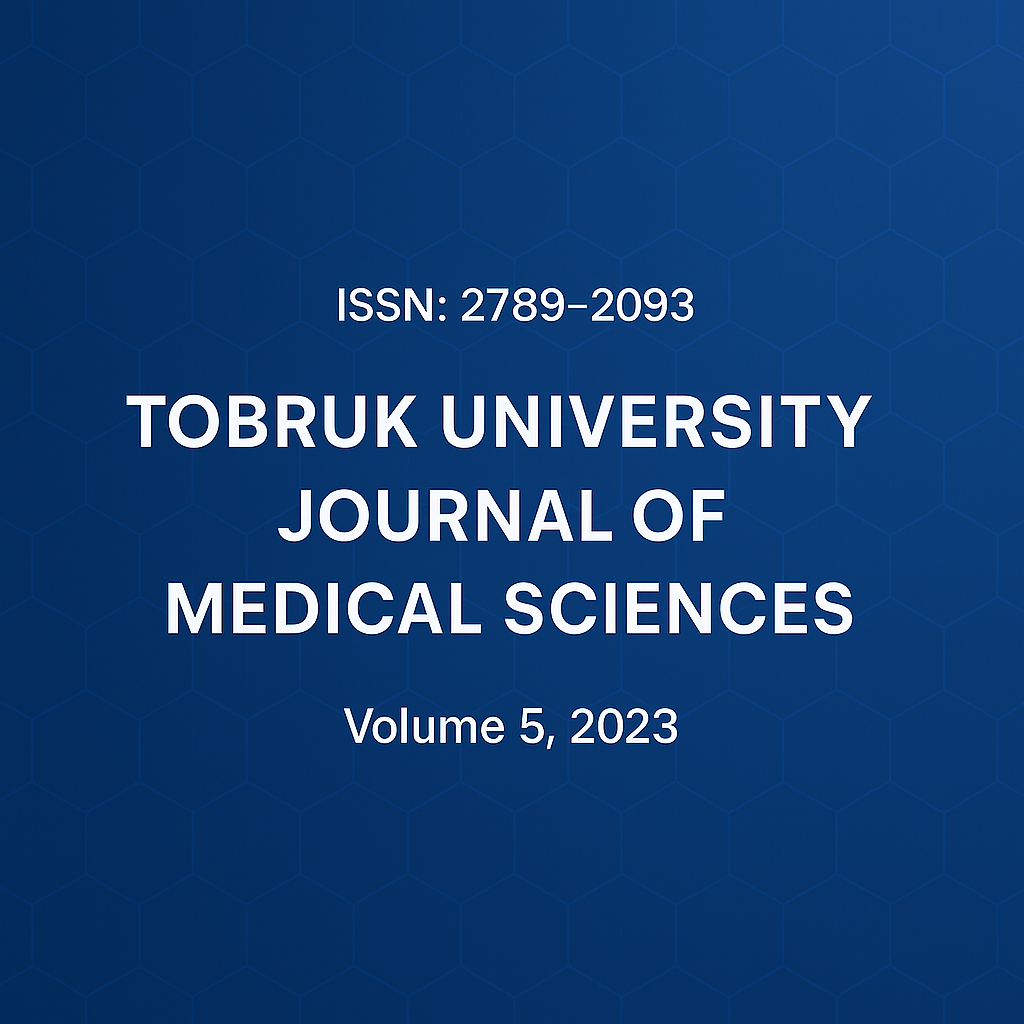Relationship between Environmental Pollution and Different Diseases.
DOI:
https://doi.org/10.64516/a8fvfw67Keywords:
Pollution,, Chronic Granulomatous Disease,, Typhus,, Tuburcoloisus,, Hepatitis.Abstract
Environmental pollution effects on public health. It aims to determine the relationship between Environmental Pollution and Various Diseases. Method was cross-sectional survey from different hospital and polyclinic in Derna city. Results show the young ages (> 1 year - 10 years ) have high frequency and percent 146 (48.7%) in infected by different diseases, followed by )21 year – 30 year (by 66(22.0 %), S.D(1.24), Mean(2.10), The percent of infected male was 200 (66.7 %) higher than females 100(33.3 %), SD was (0.472), Mean(1.33), the percent of West Accumulation 262(87%), SD(0.33315), mean (1.1267). As for the Insect distribution was 261 (87.0%), the water source the highest percent was for Center Of City by 61(20.3%), followed by plastic tanks 48(16.0%), Metal tanks 46(15.3%), Well 53(17.7%), Mean, (3.3167) SD(1.45031). the tuburcoloisus was have a high percent by 83(27.7%), followed by lice 49(16.3 %), followed by Hepatitis A infection by 48(16%) Chronic Granulomatous Disease (CGD) 34 (11.3 %), Rabbis, 32(10.7 %) ,Typhus 13( 4.3 %), and ( Hepatitis B , 7(2.3%) , Hepatitis C,6 ( 2.0%), the Std. Deviation was(3.178 ), Mean (7.87), The percent of infected Libyan 267(89.0%) was higher than other nationality by 28( 12.7 %), Std. Deviation was (0.315), Mean (1.11 ). P-Value for Living Place, Water Source, west Accumulation and Insect Distribution was < 0.000. The results confirmed that the prevalence of different diseases is closely related with the current environmental situation and The Relationship between Diseases and Living Place, Water Source, and Waste Accumulation & Insect Distribution.
References
1. A. A. Aguirre, et al, (2008) ‘Global Factors Driving Emerging Infectious Diseases’, Annals of the New York Academy of Sciences, 1149.
2. S. Ahmad, et al. (2019) ‘The Impact of Water Pollution on Economic Development of Pakistan’, International Journal of Science and Business, 3(4), pp. 86–95.
3. D. B. Armstrong, (1914) ‘An Investigation Into the relationship of the house fly to disease- the special importance of the fly in infant welfare’, American Journal of Public Health, 4(3), pp. 185–196.
4. K. Balthazard-Accou, et al. (2021) ‘Vector-Borne Diseases and Climate Change in the Environmental Context in Haiti’.
5. B. Bellekom, et al. (2021) ‘A network perspective on the vectoring of human disease’, Trends in Parasitology.
6. D. Briggs, (2003) ‘Environmental pollution and the global burden of disease’, British Medical Bulletin, 68(1), pp. 1–24.
7. J. Caravanos, et al. (2016) ‘Burden of disease resulting from lead exposure at toxic waste sites in Argentina, Mexico and Uruguay’, Environmental Health, 15(1), p. 72.
8. S. Eljamay, (2018), Prevalence of Parasite among School Children in Derna City, Vol. 12(1) PCBSJ.
9. M. A. Hassaan, El Nemr, A. and Madkour, F. F. (2016) ‘Environmental assessment of heavy metal pollution and human health risk’, American Journal of Water Science and Engineering, 2(3), pp. 14–19.
10. JCI - Environmental exposures and mechanisms in allergy and asthma development (no date). Available at: https://www.jci.org/articles/view/124612 (Accessed: 31 October 2020).
11. Y. Jin, et al. (2017) ‘Effects of environmental pollutants on gut microbiota’, Environmental Pollution, 222, pp. 1–9.
12. S. Kumar, et al , (2017) ‘Water Pollution in India: Its Impact on the Human Health: Causes and Remedies’, p. 6.
13. N. Kumari, et al (2018) ‘Modeling the Dynamics of Infectious Disease Under the Influence of Environmental Pollution’, International Journal of Applied and Computational Mathematics, 4(3), p. 84.
14. K. Lam, et al. (2007) ‘Proliferating bacterial symbionts on house fly eggs affect oviposition behaviour of adult flies’, Animal Behaviour, 74(1), pp. 81–92.
15. D. I. La Milia, et al. (2019) ‘Monitoring of Particle Environmental Pollution and Fungal Isolations During Hospital Building-Work Activities in a Hematology Ward’, Mediterranean Journal of Hematology and Infectious Diseases, 11(1).
16. P. J. Landrigan, et al. (2016) ‘Health Consequences of Environmental Exposures: Changing Global Patterns of Exposure and Disease’, Annals of Global Health, 82(1), pp. 10– 19.
17. C. Lu, et al. (2018) ‘Early life exposure to environmental pollution increases childhood asthma, allergy and infection’, Chinese Science Bulletin, 63(10), pp. 954–967.
18. R. Mehrdad, et al. (2008) ‘Musculoskeletal disorders among municipal solid waste workers’, Acta Medica Iranica, pp. 233–238.
19. L. B. Murrison, et al. (2019) ‘Environmental exposures and mechanisms in allergy and asthma development’, The Journal of Clinical Investigation, 129(4), pp. 1504–1515.
20. G. U. Nzewuihe, et al. (2021) ‘A study of knowledge, attitude and practices regarding human activities and the breeding of mosquito vectors of human diseases in Ikeduru L.G.A., IMO state, Nigeria’, Journal of Entomology and Zoology Studies, p. 9.
21. D. Ae. Okpara, et al (2021) ‘Proliferation of household waste irregular dumpsites in Niger Delta region (Nigeria): unsustainable public health monitoring and future restitution’, Sustainable Environment Research, 31(1), pp. 1–10.
22. A.Patz Jonathan et al. (2004) ‘Unhealthy Landscapes: Policy Recommendations on Land Use Change and Infectious Disease Emergence’, Environmental Health Perspectives, 112(10), pp. 1092–1098.
23. A. Prüss-Üstün, et al. (2016) Preventing Disease through Healthy Environments: A Global Assessment of the Burden of Disease from Environmental Risks. World Health Organization.
24. C. E. Sanderson, et al . (2020) ‘Unchartered waters: Climate change likely to intensify infectious disease outbreaks causing mass mortality events in marine mammals’, Global Change Biology, 26(8), pp. 4284–4301.
25. J. G. Scott, et al. (2014) ‘Genome of the house fly, Musca domestica L., a global vector of diseases with adaptations to a septic environment’, Genome biology, 15(10), pp. 1–17.
26. S. Sharma, et al, (2019) ‘Dynamics of a waterborne pathogen model under the influence of environmental pollution’, Applied Mathematics and Computation, 346, pp. 219–243.
27. H. Shuval, (2003) ‘Estimating the global burden of thalassogenic diseases: human infectious diseases caused by wastewater pollution of the marine environment’, Journal of Water and Health, 1(2), pp. 53–64.
28. J. H. Spencer, et al. (2020) ‘Emerging infectious disease, the household built environment characteristics, and urban planning: Evidence on avian influenza in Vietnam’, Landscape and Urban Planning, 193, p. 103681.
29. K. Srivastava, et al (2015) ‘Role of Environmental factors in Transmission of Tuberculosis’, p. 12.
30. N. Stroeymeyt, et al. (2018) ‘Social network plasticity decreases disease transmission in a eusocial insect’, Science, 362(6417), pp. 941–945.
31. Y. Suleman, et al. (2015) ‘Solid waste disposal and community health implications in Ghana: Evidence from Sawaba, Asokore Mampong municipal assembly’, J Civil Environ Eng, 5(6).
32. A. Suk William, et al. (2016) ‘Environmental Pollution: An Under-recognized Threat to Children’s Health, Especially in Low- and Middle-Income Countries’, Environmental Health Perspectives, 124(3), pp. A41–A45.
33. Y. Sun, et al. (2020) ‘Associated Effects and Efficiency Evaluation between Wastewater Pollution and Water Disease Based on the Dynamic Two-Stage DEA Model’, Healthcare, 8(3), p. 279.
34. A. S. Thomas. (2020) ‘air pollution and nutritional transition as risk factors for non- communicable diseases : the emerging trends in health scenario of kerala, india’, p. 5.
35. H.-J. Tsai, et al. (2021) ‘Environmental Pollution and Chronic Kidney Disease’, International Journal of Medical Sciences, 18(5), pp. 1121–1129.
36. S. Whittaker, et al. (2018) ‘Air Pollution and Infectious Disease Burdens on Lung Function in the Eastern Caribbean’, ISEE Conference Abstracts.
37. X. Xu, et al. (2018) ‘Environmental pollution and kidney diseases’, Nature Reviews Nephrology, 14(5), pp. 313–324.












